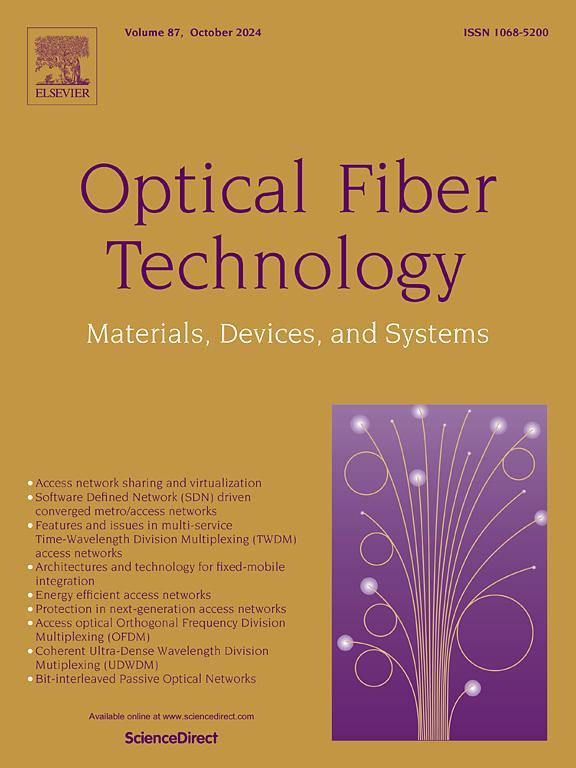Quality of transmission assured joint RMLSA for elastic optical networks
IF 2.7
3区 计算机科学
Q2 ENGINEERING, ELECTRICAL & ELECTRONIC
引用次数: 0
Abstract
The routing and spectrum assignment (RSA) presents a significant challenge in the elastic optical networks (EONs). Integrating adaptive modulation formats into the RSA problem, i.e. routing, modulation level and spectrum assignment (RMLSA), increases allocation options heightening complexity. The conventional RSA approach involves pre-determining a fixed number of paths and subsequently allocating spectrum within them separately. However, expansion of path set for optimality may not be advisable due to the substantial increase in paths with network size expansion. This paper explores a novel RMLSA, proposing a comprehensive solution addressing route determination and spectrum assignment concurrently. Finding an optimal solution for dynamic traffic is not feasible due to the unknown future connections. However, allocating resources with better utilization and lower average fragmentation enhances the likelihood of successfully accommodating future connections. So, an objective function has been chosen and designated as ABACUS, adaptive balance of average clustering and utilization of spectrum. This nomenclature highlights the objective function’s capability to adjust and assign significance to ”average clustering” (lower fragmentation) and ”spectrum utilization”. Our approach involves formulating an integer linear programming (ILP) model with a simple relationship between path and spectrum constraints. The model also integrates physical layer impairments (PLIs) to guarantee end-to-end quality of transmission (QoT) for requested connections while upholding existing ones. Towards this goal, we adopted a structured formulation approach where essential information is determined beforehand, minimizing the need for online computations. The simulation results indicate that this approach reduces the spectrum resource utilization while improving network’s average fragmentation which contributed to a lower bandwidth blocking probability across all arrival rates.
弹性光网络中保证传输质量的联合RMLSA
在弹性光网络中,路由和频谱分配(RSA)是一个重要的挑战。将自适应调制格式集成到RSA问题中,即路由、调制级别和频谱分配(RMLSA),增加了分配选项,从而提高了复杂性。传统的RSA方法包括预先确定固定数量的路径,然后在其中分别分配频谱。但是,为了最优性而扩展路径集可能是不可取的,因为随着网络规模的扩大,路径会大量增加。本文研究了一种新的RMLSA,提出了一种同时处理路由确定和频谱分配的综合解决方案。由于未知的未来连接,寻找动态流量的最优解是不可行的。然而,以更好的利用率和更低的平均碎片分配资源可以提高成功容纳未来连接的可能性。为此,本文选择了一种目标函数ABACUS,即平均聚类与频谱利用率的自适应平衡。这种命名法强调了目标函数调整和分配“平均聚类”(较低碎片化)和“频谱利用率”的重要性的能力。我们的方法包括制定一个整数线性规划(ILP)模型与路径和频谱约束之间的简单关系。该模型还集成了物理层损害(PLIs),以保证所请求连接的端到端传输质量(QoT),同时维护现有连接。为了实现这一目标,我们采用了结构化的公式方法,其中基本信息事先确定,最大限度地减少了对在线计算的需求。仿真结果表明,该方法在降低频谱资源利用率的同时,提高了网络的平均分片率,从而降低了所有到达速率下的带宽阻塞概率。
本文章由计算机程序翻译,如有差异,请以英文原文为准。
求助全文
约1分钟内获得全文
求助全文
来源期刊

Optical Fiber Technology
工程技术-电信学
CiteScore
4.80
自引率
11.10%
发文量
327
审稿时长
63 days
期刊介绍:
Innovations in optical fiber technology are revolutionizing world communications. Newly developed fiber amplifiers allow for direct transmission of high-speed signals over transcontinental distances without the need for electronic regeneration. Optical fibers find new applications in data processing. The impact of fiber materials, devices, and systems on communications in the coming decades will create an abundance of primary literature and the need for up-to-date reviews.
Optical Fiber Technology: Materials, Devices, and Systems is a new cutting-edge journal designed to fill a need in this rapidly evolving field for speedy publication of regular length papers. Both theoretical and experimental papers on fiber materials, devices, and system performance evaluation and measurements are eligible, with emphasis on practical applications.
 求助内容:
求助内容: 应助结果提醒方式:
应助结果提醒方式:


